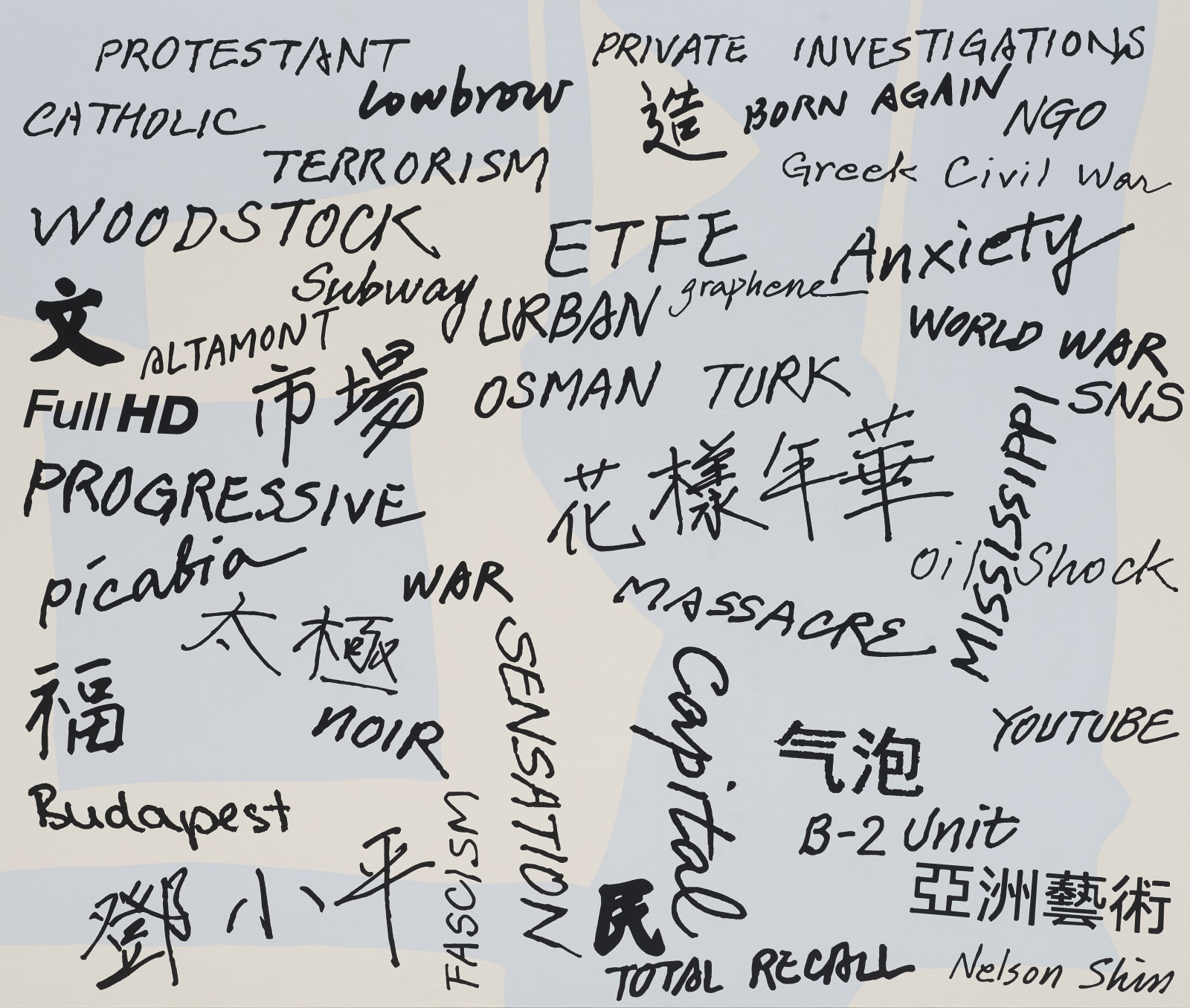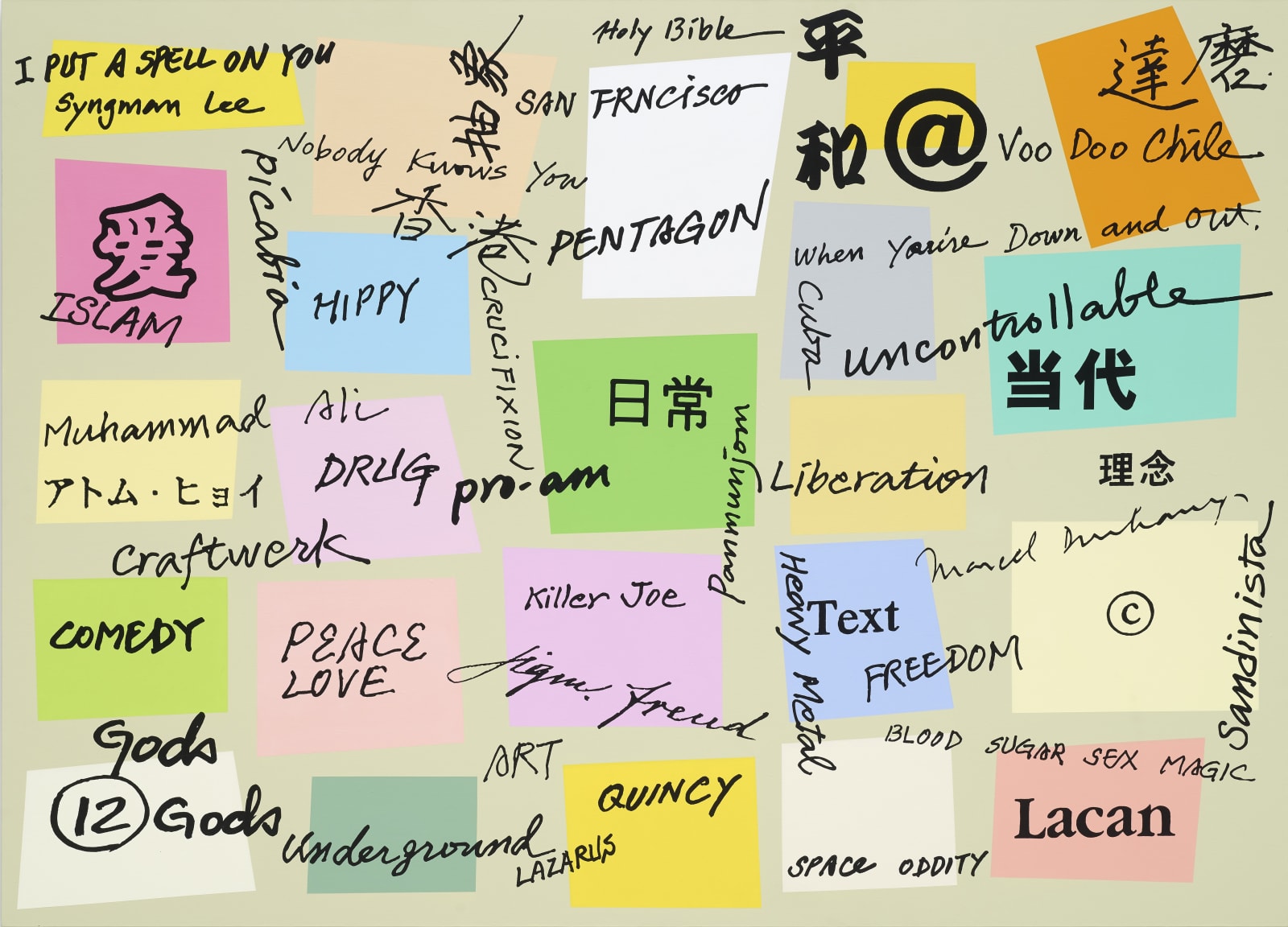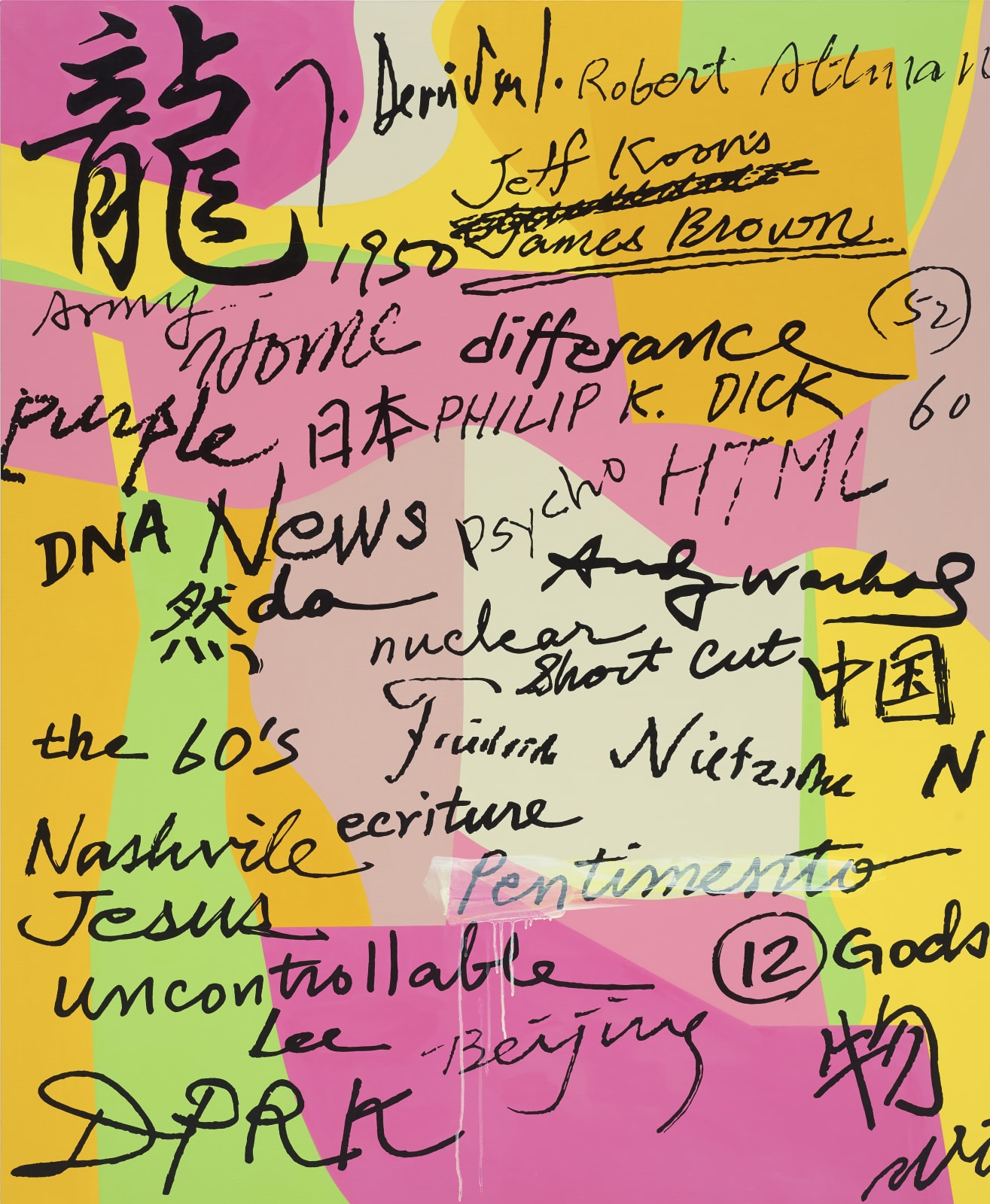Words: 이동기 Dongi Lee
“신문과 가위를 준비하라. 당신이 시를 쓰려는 만큼의 신문기사들을 선택하라. 그 기사를 가위로 잘라라. 잘라낸 기사를 다시 단어 단위로 잘라내고 봉투에 넣어라. 단어들이 섞이도록 흔들어라. 그리고 단어를 하나씩 꺼내 나열하라. 나열된 단어를 종이에 받아 적으면 당신이 마음에 들어 할 시가 될 것이다. 당신은 시인이 되었으며 그 시는 비록 사람들이 이해하기 어렵겠지만, 무궁무진하며 매력적인 감성을 지니게 될 것이다.”– <How to Make a Dadaist Poem>, 트리스탄 짜라(Tristan Tzara)
다다이스트의 시는 얼마나 의미심장하고 얼마나 표현적인가! 단어를 비논리적으로 접속시키는 것은 어려운 일이다. 그것은 각각 의미가 담겨 있고 문법에 따라 그 쓰임이 결정되어 있기에 이미지처럼 우연과 추상적인 조작에 곧잘 응하는 것이 아니다. 그래서 단어의 비문법적 나열의 상태가 우연성의 효과를 더욱 증폭시킨다. ‘읽을 수’는 있으나 ‘이해할 수’는 없는 다다이스트의 시는 이미지보다 더 강렬하게 우연성의 신비를 시각화한다.
이동기의 개인전 <Words>는 2017년부터 제작한 신작 시리즈를 선보인다. 캔버스에는 여러 낱말이 파편적으로 흩어져 있다. 대부분은 그의 글씨체이며 일부는 타인의 글씨체 혹은 컴퓨터 폰트를 활용했다. 의도적으로 선택한 단어도 있고 그저 인쇄물이나 인터넷상에서 추출한 단어도 있다. 그리고 명백하게도 단어들 사이의 연관성은 없다. 그림을 어떻게 완결시킬지 미리 계획하거나 조형성을 의도하지 않고 단어와 단어의 비선형적인 배치와 거기서 발생하는 혼돈의 상태가 그림 전면을 지배한다. 이 사건을 만들어낸 장본인은 화가의 무의식적 심상이거나 혹은 외부의 어떤 힘이 아니었을까. 이 불가사의한 조력자는 자아의 일부를 형성하며 의식의 통제를 벗어난 상태에서 비로소 얼굴을 세상에 내민 것이다.
이동기의 그림이 오로지 무의식적 상태에서 잉태된 것이라면 논박의 여지는 없을 것이다. 이와 반대로 그의 그림에는 어떠한 메시지, 명확한 단어의 의미 전달도 의도되었다. 문제는 여기에 있다. 특정한 의도, 의식에 의한 단어 조합은 언어의 기의, 개념에 집중하는 것이다. 그림을 하나의 완결된 ‘오브제’로 간주하는 것이 아니라 의미를 전달하는 메시지 즉, 전달 매체로 기능하는 것이다. 이것이 개념미술의 전략이다. 개념미술가들은 예술의 물질적 형태가 부재한 가운데에서도 예술의 개념(메시지)이 작용할 수 있다고 믿었다. 개념미술에서 언어가 중요한 위치를 차지할 수 있었던 것은 언어가 가진 상징성과 매체성 때문이다.
그림의 조형적 형태를 미리 계획하지 않는다는 점에서 이동기의 이번 낱말그림은 이전의 추상화 시리즈와 연결된다. 스프레이가 분사되면서 만들어낸 우연적인 형태나 물감이 물리적인 힘으로 만들어낸 불규칙한 형태는 화가의 의지나 판단으로 조절되지 않는다. 또한, 낱말과 낱말 사이에 의미가 연결되지 않고 화면 안에서 서로 충돌한다는 점은 절충주의 시리즈와 접점을 이룬다. 이동기의 작업을 관통하는 것은 이미지의 결합을 통해 발생하는 비합리적이고 우연적인 효과에 있다. 낱말그림은 절충주의 시리즈의 이미지가 문자로 전환된 상황인 것이다.
하나의 새로운 양식을 취할 때, 그것은 분명 화가가 ‘다른’ 말을 하려고 하는 것이다. 그림에 언어를 사용할 때 그는 ‘화자’ 즉, 말하는 사람이 된다. 이미지는 실제의 사물과 불가분의 관계를 갖는다. 관자는 이미지와 실제 대상과의 유사성을 발견하게 되면 작품을 이해했다고 판단한다. 그러나 언어(단어)는 단순히 읽는 것으로 끝나지 않고 그 의미를 되새기면서 쓰여진 맥락을 찾아야 비로소 이해했다고 볼 수 있다. 더욱이 이미지는 배치의 순서나 규칙이 없기 때문에 어떠한 형태로든 수용될 수 있으나 언어는 문법적 체계를 가지고 있기에 그러한 혼란스러운 상황은 용납되지 않는다. 이동기의 작업에 있어 이질적인 요소의 충돌, 의식과 무의식의 혼돈, 합리성과 비합리성의 긴장 상태는 문자를 통해 더욱 고조된다. 불편한 그림이다.
이동기는 새로운 작품 시리즈를 선보일 때마다 이전 시리즈와 전혀 다른 조형기법을 추구한다. 시리즈와 시리즈 사이엔 발전도 없고 퇴보도 없으며, 언제나 별개의 작품으로 종결된다. 혼란을 야기시키며 모순들로 가득 차 있으나 이는 놀라운 일이 아니다. 화가 자체가 오해와 논란을 불러일으켰기 때문이다. 이 모든 사태는 이동기 스스로가 자처한 일이다. 의도적으로 형식적 일관성을 거부하는 것은 화가의 윤리적 태도가 내포되어 있다. 사실 처음부터 그의 그림은 이미지로 우리에게 말을 걸고 있었는지 모른다. ‘이미지의 생산 주체는 누구인가’, ‘(이미지를 생산하는 데 있어서) 과연 예술가에게 전지전능한 창조력이 존재하는가’라는 질문 말이다. 예술에 대한 믿음과 불신, 우연과 필연, 긍정과 부정, 도덕과 비도덕이 공존하는 이 혼돈의 사태는 어쩌면 예술의 관습적인 편견을 몰아내려는 방편이 아니었을까. 허탈할 일도 놀라운 일도 아니다.
“Take a newspaper. Take a pair of scissors.Choose an article as long as you are planning to make your poem.Cut out the article.The cut out each of the words that make up this article and put them in a bag.Shake it gently.Then take out the scraps one after the other in the order in which they left the bag.Copy conscientiously. The poem will be like you.And here are you a writer, infinitely original and endowed with a sensibility that is charming though beyond the understanding of the vulgar.“ - <How to Make a Dadaist Poem>, Tristan Tzara.
A Dadaist poem is so meaningful and expressive. It is not easy to align words in an illogical order. Each word has its unique meaning, and each usage is determined upon a grammatical necessity, where words does not normally respond to a coincidental and abstract mechanism such like an image. That is why an ungrammatical array of words amplifies the randomness. A Dadaist Poem, which one can “Read” yet cannot “Understand” visualizes the beauty of randomness stronger than an image.
LEE‘s exhibition <Words> displays a new set of pieces created since 2017. Numbers of words are scattered on the canvas. The majority of words are from his own hand writing, and several others are from hand writings of others or from a computer font. The words are a mixture of intentionally selected words or random words abstracted from fine prints or from the internet. And, obviously, each words do not have any relation with each other. No efforts in planning how the piece will be completed, or intending any formation within the piece were made, and only the non-linear scattering of words, and the chaos created from such randomness dominates the entirety of each piece. One should imagine that the unconsciousness of the painter or an external force is responsible for the result. This mysterious helper construes a part of the ego, and finally reveals itself when consciousness loses control.
There would be no room for debate, if LEE‘s pieces were made under a purely unconscious state. On the contrary, each of his piece has an intention of a specific message, and the specific meaning of words. This is key. A combination of words with a specific intent, or consciousness focuses on the meaning and concept of language. Each of his piece does not construe a complete ‘Object’, but rather functions as a medium to relay a specific message. This is the strategic approach of conceptual art. Conceptual artists believes that the concept of art (message) works even in the absence of a physical form of art. Accordingly, with its genuine symbolism, and mediality, language is a key component of conceptual art.
In the perspective of not planning any formation of the piece, LEE‘s word pictures revealed in this exhibition is connected with his previous abstract series. The random display created from a simply spray, or the irregular form presented by the physical force of paint can not be controlled by the intention or decision of the artist. Furthermore, the collision of random words within the screen meets with the eclecticism series. The non-reasonable and random effect created by combining image blankets LEE‘s work. Word pictures are a conversion from images in an eclecticism series to words.
When an artist adopts a new style, it is obvious that the artist wants to make a ‘different’ voice. When words are employed in a picture, the artist becomes a ‘Speaker’. An image has an inseperable relation with the actual object. A viewer determines his/her comprehension of an art piece once he/she recognizes the resemblance of an image to the actual object. However, language (words) do not end by simply reading the prose itself, while once the reader reminisce the meaning and understand the context of the prose, then the reader can comprehend the art piece. Moreover, an image does not have a sequence or rule on its array, allowing one to accept the image in any shape or form, while language, with all of the grammar and syntax, does not allow such chaotic randomness. In LEE‘s art, the collision of different elements, the chaos between consciousness and unconsciousness, and the tension between reason and non-reason is amplified through words. His art is not for the viewers comfort.
In every new series, LEE pursues forming techniques totally different from his previous series. Each and every series construe independent pieces with no revolution nor regression between each other. Unsurprisingly so, his pieces create chaos and is full of contradictions. The artists himself, brings upon chaos and misunderstandings. All of this criticism is self-own. Purposely refusing consistency in formation implies the ethical standpoint of the artist. His pieces may have been asking us ‘Who is responsible to create an image?’ or ‘Is an artist the omnipotence creator to create an image?’ from the beginning, who knows. The coexistence of trust and distrust of art, randomness and inevitability, rational and irrational may be the mean to remove any underlying bias in art. It‘s nothing to be discouraged for, or be surprised with.













